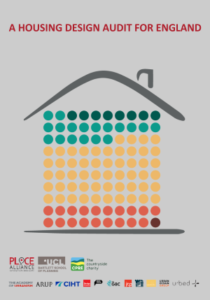Housing Design Quality Matthew Carmona
A Housing Design Audit for England (2020) - 'shows promise but must do better'
By Justin Webber (Chair of the RTPI Urban Design Network)

Chair of the RTPI Urban Design Network, Justin Webber, comments on 'A Housing Design Audit for England' – a report, conducted by University College London (UCL) for the Place Alliance and the Campaign to Protect Rural England, which was launched on 21 January 2020.
Historians tend to simplify the processes and personas that define developments over time. Given that narrative is 'linear' and action is 'solid', this is, of course, partly about practically presenting complex data in an accessible format. However, in the case of exploring the genesis of the new Housing Design Audit for England, there actually is a fairly simple narrative. The work comes out of the 'Place Alliance', a partnership promoting design quality that was created by Prof Matthew Carmona in 2014 as something of a rearguard action in the face of losses to much of the institutional capacity that had previously been built up.
The loss of the national quango - the Commission for Architecture and the Built Environment (CABE), in 2011 was significant, both practically and symbolically, but changes at the local level have arguably been even more impactful. As reported by the RTPI, a reduction of 42% in funding for local authority planning teams over the past decade has seen a significant loss of capacity, with detailed research by the Institute of Historic Building Conservation showing in-house specialisms fairing particularly badly.
Authored by Carmona and his team at UCL, the new report gained added weight through broader stakeholder buy-in, ranging from Civic Voice to the Home Builders Federation. Benefiting from appearing in the middle of a broader debate on the quality of new development in the country, the headline figures from the report are referenced on the first page of theLiving with Beauty report, published on 30 January, by the Building Better, Building Beautiful Commission.
The launch and the actual report inevitably have a sense of déja-vu for anyone who has followed design debates for a while, something acknowledged by the authors with references to their past work and the regional housing design audits published by CABE in the mid-2000s. This dynamic is a central one, with relative performance from the new research working off the benchmark of the CABE audits. Arguably this 15 year gap is also the most important facet of the work. We can all think of a disappointing development that has appeared, but good planning is based on sound evidence gathering, rather than anecdote, and the new national housing audit is an attempt to provide something more robust on the current state of play in England.
Although some of the media coverage has presented the audit as a damning indictment of the development industry, the actual report is more nuanced. Running to over 100 pages, the research critiques contemporary volume housing schemes against the now well-established matrix of urban design criteria. The good news is that there has been some measurable progress in recent years, primarily in some of the more technical aspects, such as the Secured by Design criteria and housing mix. A minority of schemes perform strongly more generally, but this strength, paradoxically, provides the hook for the more challenging conclusions that follow.
Around half of schemes are rated as being mediocre – exhibiting extensive missed opportunities, with another quarter rated as being sufficiently poor to be uncompliant with national planning policy on good design and therefore of a form that the authors conclude should not have been granted planning permission. If planning policy and guidance is essentially there – on a general level at least, and developers have demonstrated they can deliver outstanding design quality across the country, the report questions what has gone wrong.
Local authorities are encouraged to be more demanding and use tools such as design codes and design review more extensively. Developers are encouraged to be more ambitious across their whole portfolios. The most systemic issues identified relate to highway design and the need still to move from a risk reduction rationale to more holistic place-making. Less affluent communities are shown to typically get worse design, despite the report providing evidence that better design need not be unaffordable. Interestingly, greenfield schemes score worse than those on more complex brownfield sites, suggesting that where developers must respond to the complexity of existing built form, standard designs are augmented and a greater 'sense of place' follows. As the old proverb goes: 'necessity is the mother of invention'.
The report itself has not been immune from criticism, with the most vocal complaints focussing on the partial nature of coverage across regions, with assessed schemes focussed on particular sub-regions. As alluded to before, this reflects the practical limitations of a project coming from a small team at UCL, rather than a more systematic government-funded research project. In truth, the regional 'league table' is not entirely helpful, but the focus on schemes across the country certainly is and the broader conclusions ring true. Coming from people who spend much of their lives teaching, the conclusion on the design quality is fittingly: 'shows promise but must do better'.
Other content you might be interested in
Housing Design Quality Matthew Carmona
Source: https://www.rtpi.org.uk/blog/2020/february/a-housing-design-audit-for-england-2020-shows-promise-but-must-do-better/
0 Response to "Housing Design Quality Matthew Carmona"
Post a Comment